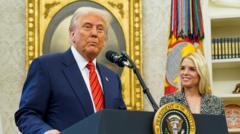The clothing trade for many factories in Guangzhou is stalling as rising tariffs and increased import taxes hit profit margins. Factory owners like Liu Miao struggle to adapt, considering alternative markets while facing the realities of rising operational costs.
China's Garment Industry Faces Crisis as Tariffs Increase Pressure on Factories

China's Garment Industry Faces Crisis as Tariffs Increase Pressure on Factories
As the U.S. imposes new tariffs, garment manufacturers in Guangzhou are being forced to reassess their business strategies, leading to significant challenges in the apparel market.
In the vibrant textile hub of Guangzhou, China, factories that have thrived on exporting apparel to the United States are now at a crossroads due to escalating tariffs. Liu Miao, a small factory owner, has seen his business halt dramatically as new tariffs and taxes have eroded profit margins on sales to platforms like Amazon. Previously earning around $1 for each garment, Mr. Liu now struggles to make a mere 50 cents per item sold.
In a city renowned for its bustling garment trade, businesses have flourished thanks to platforms that connect Chinese manufacturers directly to U.S. consumers. A tax loophole allowing low-value packages to enter the U.S. duty-free has significantly aided this booming e-commerce. However, the tightening grip of tariffs now threatens not just individual businesses but the entire economic landscape surrounding garment production in Guangzhou.
As trade tensions escalate between the U.S. and China, entrepreneurs like Mr. Liu find themselves grappling with narrow profit margins and increased operational expenses. The once-bustling garment district, filled with activity and luxury vehicles, is now casting a shadow as uncertainty looms over the future of exports.
With the current market climate, many factory managers are re-evaluating their strategies, contemplating moves to more affordable production locations or targeting alternative markets. For many, the pain of these tariffs is not just felt in their pocketbooks but resonates through their workforce as well, resisting pay cuts to maintain morale and productivity.
As factories close their doors to the U.S. market, the implications of U.S.-China trade tensions ripple through the industry, marking a significant shift in a sector that had previously enjoyed rapid growth through digital marketplaces. The future of garment manufacturing in Guangzhou hangs in the balance as manufacturers brace for uncertainty in the face of changing global trade policies.





















